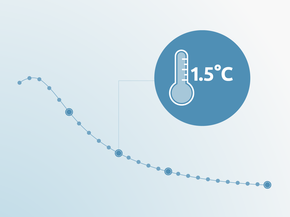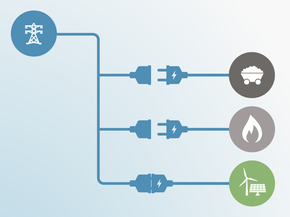Current Policy Projections
Overview
Under current policies, annual emissions from all sectors (excluding LULUCF) are still projected to grow significantly, namely by about 56% above 2010 levels by 2030, reaching about 490 MtCO2 in 2030. This is equal to doubling 1990 emissions levels, and means missing its NDC values by a large margin.
Our analysis of current policies is based on the mitigation scenarios underlying the third National Communication of Argentina to the UNFCCC (Secretariat of Environment and Sustainable Development 2015). Additional policy scenarios, assuming a full implementation of the renewable targets and additional energy efficiency measures, shown in our analysis are based on the Energy Scenarios from the Ministry of Energy (Ministry of Energy and Mining Argentina 2018b).
Depending on these variables Argentina might overachieve its unconditional NDC target or miss it by a wide margin, unless additional action is taken. In the last months, a push by parts of the government towards the exploitation of national oil and natural gas resources has threatened progress in this direction (see more detail in the section on energy supply below).
Argentina is going through a severe economic crisis, which also has led to changes in the structure of ministries with the objective to decrease government spending. Included in these changes are departments dealing with climate change: the former energy ministry and the environment ministry both became secretariats, reporting to the Ministry of Economics and the president’s office, respectively. Similarly, the Ministry of Agriculture is now a Secretariat of the Ministry of Production (Government of Argentina 2018b). It is unclear whether the structural change will have an impact on climate policy. The direct impact of decreased economic activity on emissions is also still unclear. The GDP projections underlying the current policies projections do not consider the current recession. The scenarios do not provide total GPD growth. The growth of the production value is estimated around 3% for most sectors (Government of Argentina 2015b).
In December 2017, Argentina adopted a carbon tax covering all fossil fuels sold in Argentina, based on a price of 10 USD/tCO2e (FARN 2017; Ministerío de Justicia y Derechos Humanos 2017). The impact of the tax on emissions has not yet been quantified. This comprehensive tax is a very good first step in the right direction. Some international sources suggest significantly higher carbon prices are required for Paris compatibility (at least USD 40–80/tCO2 by 2020 andUSD50–100/tCO2 by 2030 (Stiglitz et al. 2017). Our policy projections, as well as the new scenarios from the Ministry of Environment, do not yet specifically reflect the recently implemented carbon tax, and no studies exist quantifying the impact. An earlier proposal in Argentina included a carbon price of 25 USD/tCO2e but the final decision was for a much weaker tax. National NGOs have criticised the final rule as too unambitious and merely a tool to align with international activities to increase the chances for accession to the OECD, rather than an instrument to safeguard the environment (FARN 2017). The law distributes the tax revenues to different areas, most not directly linked to climate change or environmental issues (Ministerío de Justicia y Derechos Humanos 2017).
Energy supply
The government of President Mauricio Macri has introduced various policies that can potentially reduce emissions of the energy sector, including a renewable energy law and a biofuels law (Government of Argentina, 2015b & Government of Argentina, 2016b). The renewable energy law (Law 27191), published at the end of 2015, aims to increase the share of renewables (including hydro smaller than 50 MW) in total power generation to 20% by 2025 (Government of Argentina 2015a). An auctioning scheme—RenovAr—supports this target. Up to now, three auctioning rounds were held (RenovAr 1, 1.5 and 2), leading to contracting of 4.7 GW of renewable electricity (Ministry of Energy and Mining Argentina 2018a).
In September 2018, the Argentinian government announced a fourth round (RenovAr 3), under which it will tender 0.4 GW of renewable electricity installations. RenovAr 3 will focus on small-scale renewables, with a capacity up to 0.01 GW per installation to be connected to the medium-voltage grid (Pozzo 2018). This limitation in size results from problems with grid capacities in the high-voltage grid(ibid).
Concerns about grid access have been raised, potentially causing a delay in the grid connection of the contracted capacities and making additional bidding rounds more difficult to realise. The national grid operator CAMESSA has recognised this issue already and is working on the extension of the electricity grid (Télam 2017; CAMMESA 2018). However, at this point in time CAT could not find an indication of a clear timeline, and the CAMMESA documentation specifically states that no legal claims can be made based on a delay in access to the electricity grid (CAMMESA 2018). A positive effect of the focus on small-scale is the opening of the market to private stakeholders (Pozzo 2018).
The increasing focus of the parts of the government on exploiting national oil and natural gas resources is a development potentially endangering the expansion of renewable energy, and risking increasing emissions and significant stranded assets. The Secretary of Energy, Javier Iguacel, is promoting the “Vaca Muerta” shale gas reserve as a source of cheap oil and gas for national consumption, but also for export (Secretaría de Energía Argentina 2018). Iguacel entered into office in June 2018. Before his political career, he held various positions in the petroleum industry, including high-level positions at Pluspetrol, leading the development of “Vaca Muerta” (Government of Argentina 2018a).
Available projections for the energy sector vary significantly in their assumptions on energy split and demand. The following table compares indicators for the year 2025 from three scenarios for the electricity sector:
- The Mitigation Scenarios 2015, which the Argentinian government used as the basis for its 3rd National Communication (Ministry of the Environment and Sustainable Development, 2015).
- The Energy Scenarios 2030, which the former Ministry of Energy and Mining published in early 2018 to provide additional scenarios under different assumptions (Ministry of Energy and Mining Argentina 2018b).
- The “Capacities underway” scenario, which CAT developed based on currently installed capacities and projects in the pipeline. This includes the RE capacities tendered under RenovAr and the Candu nuclear reactor. For large hydro, we assume capacity additions as in the Mitigation Scenarios 2015.
The Mitigation Scenarios 2015 are the basis for our current policy projections, the Energy Scenarios 2030 the basis for the additional policies scenario range, the “capacity underway“ scenario shown as comparison.

The “Plataforma Escenarios Energéticos”, an initiative of Argentinian think tanks and NGOs, has also published estimates of the current trends (Fernandez 2018). Their “BAU” scenario leads to only 4% of renewable electricity generation (excl. large hydro (>10 MW)) by 2035. No data is provided for 2025. The Plataforma is planning an update of the scenarios in late 2018.
In comparison to the “Mitigation Scenarios 2015”, the “Capacities underway”-scenario shows higher electricity generation from renewable sources, but lower nuclear generation. The two scenarios result in similar emission levels from the electricity sector, which is why we use emissions estimates from the Mitigation Scenarios. The electricity related emissions from the Energy Scenarios 2030 are much lower, given higher shares of renewables and an overall lower electricity demand at the lower end of the scenario range.
While the Energy Scenarios 2030 represent a detailed representation of possible future planning for the energy sector, additional actions need to be taken to achieve the share of low-carbon electricity supply assumed by the scenarios. One important area of improvement is the above-mentioned grid integration: the energy scenarios assume a large amount of additional wind capacity in Patagonia (Ministry of Energy and Mining Argentina 2018b). Investments in the electricity grid will be critical to transport the electricity generated to urban centres. With the focus of the new Secretary for Energy on oil and gas exploitation and distribution, reaching the renewable energy penetration indicated in the Energy Scenarios 2030 seems less likely than in our previous assessment in May 2018.
Transport
According to the Mitigation Scenarios 2015, emissions from transport will increase by 50% in the coming decades from 55 MtCO2e/a in 2012 to 80 MtCO2e/a in 2030 (Ministry of the Environment and Sustainable Development, 2015).
For fuel switch, the biofuels law (Decree 543/16) adopted in March 2016 requires a minimum 12% of bioethanol blend in transport fuels from 2016. Calculating the impact of this policy, we find this implies a minor improvement of emissions compared to the Mitigation Scenarios 2015, even if we assume that the production of biofuels is carbon neutral, which is disputable (DeCicco et al. 2016).
Agriculture
Agricultural emissions in Argentina (~110 MtCO2e/a in 2014 according to the national inventory) contribute a share of about 30% of total national emissions (incl. LULUCF). Agricultural products are an important part of Argentina’s exports, and the activities as well as related emissions are set to increase further, according to the Mitigation Scenarios 2015. The “Ley del Bosque Nativo” (see section “Forestry”) also includes incentives for sustainable agro-forestry. Considering the high level of methane emissions, combined with the associated deforestation this activity has caused, the agriculture and cattle-ranching sector offers great potential for Argentina to constrain its emissions.
Forestry
Emissions from LULUCF contribute with a decreasing share to the total. We have observed a clear trend in decreasing LULUCF emissions since 2010. In 2007, Argentina established the “Ley de Bosque Nativo” (Native Forests law), which controls the reduction of native forest surface, aiming at achieving net-zero change in forest areas. The law sets minimum budgets to be spent on forest protection, established a capacity building scheme and requirements for provinces to comprehensively monitor and track forests areas. In the late 1990s, Argentina implemented the law for investments in afforestation and preventing forest degradation. According to Argentina’s Second Biennial Update Report, this law has led to an additional 31 thousand hectares of forest area per year on average (Government of Argentina 2017).
In the Mitigation Scenarios 2015, the Argentinian government expects emissions from the sector to decrease further, from about 90 MtCO2e in 2012 to 37 MtCO2e in 2030. IIASA calculates emissions remain roughly at 2010 levels, at slightly above 100 MtCO2e/a (Kuramochi et al. 2017). For comparison: For calculating absolute emissions levels excl. LULUCF resulting from the NDC, we assume that the share of the LULUCF emissions in 2030 will be similar to the share of these emissions in the NDC’s BAU scenario, at 77 MtCO2e in 2030.
Further analysis
Latest publications
Stay informed
Subscribe to our newsletter






